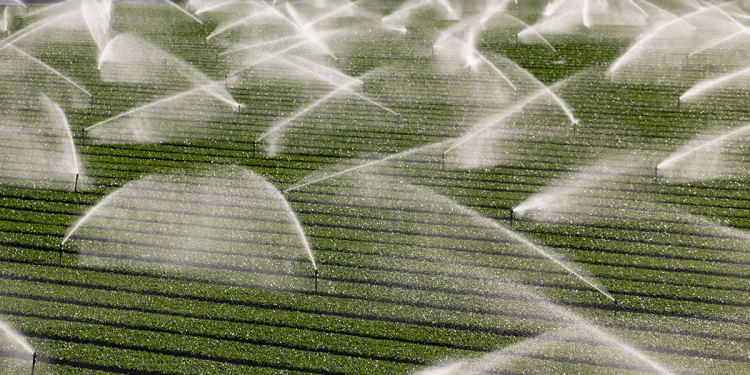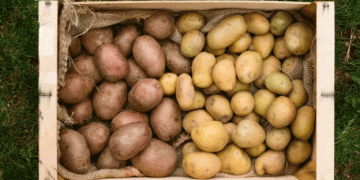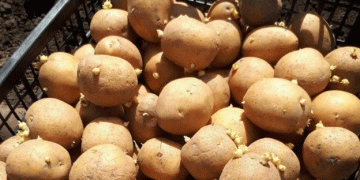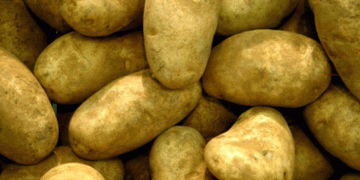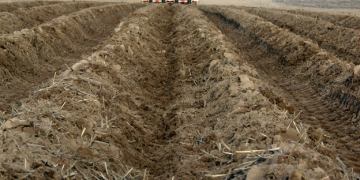A fertiliser program for potatoes growing in sandy soils must balance environmental risk with maximising returns. Coastal sands are naturally infertile and require higher rates of nutrients than loams. Efficient use of nitrogen, potassium and magnesium requires applying most fertiliser after planting and crop emergence. This also applies to phosphorus on very low phosphorus fixing grey/white sands. Pre-plant applications of phosphorus are usually adequate for yellow and red/orange sands. Post-emergent applications of soluble forms of calcium can improve plant uptake and tuber quality.
Introduction
This page outlines a general fertiliser program for fresh market winter and summer sown potatoes grown on coastal sands in Western Australia. This fertiliser program does not take into account nutrients applied to the crop in forms other than chemical fertiliser, such as organic amendments.
The recommendations cover the yellow (Karrakatta) and red-orange (Spearwood and Tuart) sands. These fertiliser rates are a guide for fresh market potatoes, although adjustments may be required for specific varieties. The recommendations assume that the fertiliser is applied through the irrigation system (fertigation). This information should be used in conjunction with other information on the fertiliser management of fresh market potatoes on sands. The program is designed to maximise returns and minimise environmental risk from leached fertilisers.
Pre-planting
Trace elements
Trace elements are essential for maximum yield. A general trace element program for sands on old and new land is detailed in web page Trace elements for potatoes grown on coastal sands. All pre-plant fertilisers should be broadcast and incorporated by rotary hoe.
Nitrogen, phosphorus and potassium
Nitrogen applied before planting can be leached. To reduce this loss, the first nitrogen application should start post-planting but before emergence. The rate of phosphorus to be applied should be determined from a pre-planting soil test. Phosphorus should be broadcast and incorporated prior to planting, along with potassium, magnesium (5kg Mg/ha) and trace elements. Broadcast and incorporate potassium prior to planting as potassium sulphate at 200kg/ha, which will supply 82kg/ha potassium.
Post-planting and emergence
Nitrogen
Apply nitrogen every week at a constant rate for both winter and summer planted crops. It is not necessary to vary the nitrogen application rate with crop stage. The recommended total rate of nitrogen is 490kg/ha for summer planted crops and 570kg/ha for winter planted crops, which is lower than the total that most producers apply. More nitrogen may be required if winter rainfall is higher than usual. The concentration of nitrogen in irrigation water should also be considered, as significant quantities of nitrogen can be applied to the crop from irrigation water, particularly during hot weather. More information can be found at Applying nutrients to vegetables via irrigation.
Potassium
Potassium should be also be applied weekly at a constant rate. Total rates of 522kg/ha for summer plantings and 602kg/ha for winter plantings are adequate for maximum yield on new land sites. On old land sites, 450kg/ha is adequate in most cases, throughout the year.
Sulphur
Sulphur is an essential element required by all crops. Sulphur applied in the trace elements and with phosphorus and potassium fertilisers is usually adequate to meet crop needs. If a low sulphur-containing phosphorus fertiliser is used (DAP for example), apply gypsum to supply sulphur if it is not provided in another form such as potassium sulphate.
Magnesium
A total of 20 to 30kg/ha of magnesium or 200 to 300kg/ha of magnesium sulphate (Epsom salts) is normally adequate.
Calcium
Calcium is an essential nutrient for plant growth. As with sulphur, crops often get their calcium requirement through other fertilisers such as superphosphate or amendments such as lime. In some areas, significant quantities of calcium can be applied through the irrigation water. Calcium should be applied if disorders such as hollow heart, brown centre or fleck are prevalent. This can be applied pre-planting as gypsum at one tonne/ha or post-planting by using calcium nitrate as a nitrogen source for some of the post-emergence applications up to a total of 100kg Ca/ha.
A summary of the suggested fertiliser program for application of N, K, Mg and Ca after planting and emergence of potatoes on sands of low N and K fertility is provided in the tables.
Urea quality
Urea often contains a contaminant called biuret which is a by-product of its manufacture. Urea with a high biuret content has been shown to damage crops, notably germinating seed and foliage if applied after planting. To minimise this problem, only use urea with a low biuret (<0.25%) content.
Fertiliser programs
| Timing(weeks post emergence) | N | Urea | K | Potassium sulphate | Mg | Magnesium sulphate | Ca | Calcium nitrate |
|---|---|---|---|---|---|---|---|---|
| Before emergence | 50 | 109 | 82 | 200 | 5 | 50 | 0 | 0 |
| At emergence | 40 | 87 | 40 | 98 | 0 | 0 | 0 | 0 |
| 1 and 2 | 40 | 87 | 40 | 98 | 0 | 0 | 0 | 0 |
| 3 | 40 | 0 | 40 | 98 | 8 | 80 | 50 | 265 |
| 4 and 5 | 40 | 87 | 40 | 98 | 0 | 0 | 0 | 0 |
| 6 | 40 | 0 | 40 | 98 | 8 | 80 | 50 | 265 |
| 7 and 8 | 40 | 87 | 40 | 98 | 0 | 0 | 0 | 0 |
| 9 | 40 | 87 | 40 | 98 | 8 | 80 | 0 | 0 |
| 10 | 40 | 87 | 40 | 98 | 0 | 0 | 0 | 0 |
| Total | 490 | 891 | 522 | 1276 | 29 | 290 | 100 | 530 |
- Use low (<0.25%) biuret urea
- Apply urea or nitrogen after planting but before emergence
- In the ‘before emergence’ row, the total nutrient applied is shown as it includes potassium and magnesium incorporated before planting
Plant testing and irrigation
Plant analysis
Use plant analysis to monitor the adequacy of the fertiliser program. It is important to take several tissue samples over the life of the crop and obtain a graph of the crop nutrient needs. The line on the graph of the nutrient analysis over time will slope or trend upwards, downwards or be constant. Compare this with what is expected for high yielding crops at the same stage as an indication of whether the fertiliser program is adequate.
A single, one-off nutrient measurement in a crop will not give an adequate indication of the trend for nutrient use across the life of the crop. To determine the nutrient needs of a crop through plant testing, petiole sampling should start when the largest or king tuber under two or three plants has reached 10mm in length.
For each planting, collect the youngest mature potato leaf from 20 to 30 plants. The youngest mature leaf is the fourth or fifth from the top of the plant. Repeat every two weeks or as necessary. Submit samples to a recognised plant testing service for analysis. The analysis results can be compared with the range of nutrient standards at each growth stage, at which the maximum yield for potatoes could be expected. More information is available at Petiole analysis for fertiliser management of potatoes on sands.
Irrigation
The suggested fertiliser applications assume the crop is not over or under irrigated and that the irrigation system applies the water uniformly. Potatoes require water to be applied to replace 100% of pan evaporation from planting to 20 days after emergence. This should be increased to 150% by 40 days after emergence. Beyond 80 days after emergence, irrigation should be reduced gradually to 100% of replacement just prior to harvest.
If using tensiometers — use blue tip sand models — they should be placed mid way between two plants within the row, with the midpoint of the ceramic cup 30cm below the top of the hill. Irrigate so the tension does not drop below about 5-7kPa from planting to the start of senescence. If rainfall is heavy and the water requirements of the crop are exceeded, additional nitrogen and potassium may be needed. Petiole analysis can assist in determining if nutrients are adequate or deficient.
